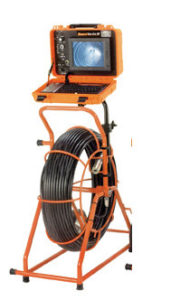 A sewer line camera is now a powerful tool in the plumbing industry. We understand the value it offers our customers.
A sewer line camera is now a powerful tool in the plumbing industry. We understand the value it offers our customers.
That is why we have invested in a sewer line camera to better meet our customer’s needs. Most homeowner’s do not understand that the sewer line buried underground on their property is their responsibility should it crack, break or no longer provide the service it’s intended to provide. As your home gets older, so does this sewer line. Your “sewer line” refers a pipe carrying water with human waste at atmospheric pressure.
Leaks and breaks are commonly caused by aging, corrosion, extreme temperatures, or settling or shifting of the ground. If this line fails, repair or replacement could cost thousands of dollars and most homeowners insurance policies or home warranty companies do not cover repairs. So, in these cases, we use our sewer line camera to inspect your sewer line. Here are some advantages:
Sewer Line Camera Inspection
It all starts with a sewer line inspection. An inspection allows our technicians to identify current or potential problems in your sewer line. Real time video image transmission allows our technicians to determine the condition of the inside of the pipe and understand any existing or potential problems. The images can also be saved for a permanent record. For example, you might not have a problem right now; but if and when you do, we have a record that enables us to quickly identify the problem the next time.
Value of a Sewer Line Camera Inspection
Here’s the value to you. Let’s say we identify a potential problem in your sewer line. For example, the ground has shifted and perhaps we have signs of aging. Yet, you may not have a break or major problem for another five years. This gives you ample time to perhaps find an inexpensive insurance solution to your problem. On the other hand, if your line is corroded or obstructed with sludge, dirt or other debris, we might be able to clean it with our sewer line jetter.
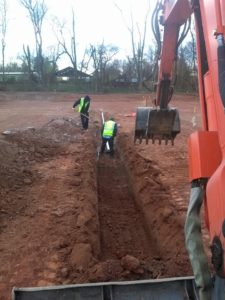 Here’s another major advantage of a sewer line camera inspection. We can often avoid or minimize the “dig.” The dig is an expensive and labor intensive process. Obviously, its much less expensive to the homeowner is we can clean the sewer line with out jetter.
Here’s another major advantage of a sewer line camera inspection. We can often avoid or minimize the “dig.” The dig is an expensive and labor intensive process. Obviously, its much less expensive to the homeowner is we can clean the sewer line with out jetter.
Or perhaps we don’t have to completely replace the entire sewer line. With our inspection, we might be able to determine if the problem is localized. In that case, we can minimize damage to your property and simply replace a section of your sewer line.
In summary, we have added a sewer line camera to our plumbing services. With our camera we can better serve our customer’s needs. The sewer system is something most homeowners don’t think about until there’s a problem. With a sewer line camera inspection we can help our customers avoid much higher costs. While this article focused on residual homeowners, this service is also available to our commercial and municipal customers.
Call our office for more information or
to schedule your sewer line camera inspection:
240-222-3205
Related Articles:
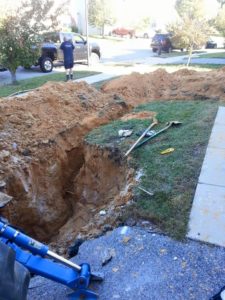 Water Line Repair is expensive! The purpose of this article is to help our readers understand the cause and effect of water line problems, and to help you identify the most common signs of water line damage.
Water Line Repair is expensive! The purpose of this article is to help our readers understand the cause and effect of water line problems, and to help you identify the most common signs of water line damage.
As a homeowner, you do everything you can to keep your homes and your loved ones safe. It’s a constant battle. You may have a warranty for appliances, health insurance for your pets, and take other preventative measures. However, most of us don’t think about our water and sewage lines, which when damaged can cause serious property damage, an increase in water and sewer bills and costly repairs. Water line repair often involves digging up your yard. This is a major expense.
You may think that this may not happen to you, but the truth is – many homeowners will suffer through this dilemma this year. In fact, based on information from the “Water is Your Business” campaign – every day there are 650 water main breaks in America, a loss of 7 billion gallons of water.
What’s more? Your local water utility or municipality is not responsible for the pipes that run through your property – you are. In other words, you are financially responsible for any necessary repairs. It may also surprise you to know that most homeowner’s insurance policies do not cover the repair costs of your water lines, which leaves your biggest investment vulnerable and your pockets empty.
Water Line Repair: Cause & Effect
Having fresh water piped into your home is essential to a comfortable daily life. And when something upsets that water flow, it’s nearly impossible to relax. This isn’t something that just happens out of the blue, the truth is there are a number of factors that make your pipes susceptible to damage over time. They include:
- The age of your pipes: The majority of the water pipes in America were installed after World War II and are in serious need of replacement. Having an idea of the age of your pipes will help you determine whether they need to be repaired or replaced – 50 is typically the magic number.
- The presence of mature trees: The tree roots of mature trees can grow into the pipes and cause blockages and clogs. Invasive tree roots often seek out pipelines because they provide vital nutrients (like water and oxygen) that the trees need to grow.
- Poor soil conditions: If you live in an area where the soil may have a high chloride content or low soil resistivity, it can cause your pipes to corrode faster than normal. If this happens, it can lead to contamination and leaks.
Water Line Repair: 3 Signs of a Damaged Water Line
There are several warning signs that can help you stop your water line damage in its path before things get worse – and more expensive. Some of them include:
- Soggy spots in your yard: If the skies in your area have been clear for a while but there are still damp spots on your lawn, this may indicate that your water line is cracked and leaking water.
- Low water pressure: If you notice that the water pressure in your home has decreased, your water line may have a leak. While there are other reasons for low water pressure, it’s better to be safe than sorry. Consult a professional to determine the cause.
- Water discoloration: Does your tap water have a rust colored tint? This type of discoloration typically happens if your pipes are rusted or even due to soil and dirt entering the cracks.
Conclusion
Because water line repair and replacement is not typically covered by homeowner’s insurance, these types of issues can cost thousands of dollars to fix. Furthermore, most homeowners do not even think about their water lines. You can’t see them, so you don’t worry about them. Thus, it’s important that you take preventative measures to keep your home protected from water damage to keep more of your money in your pocket. Pay attention to any slight changes that may affect your water lines and consult a professional for regular inspection and maintenance to avoid water line repair.
Stayed tuned for our follow up article on: 3 Factors That Impact Water Line Installation and Cost
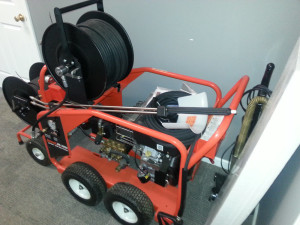 This is the third in our series of three articles on sewer line jetting. In this article, we will describe how sewer line jetting is enhanced by cameras. We will also make some recommendations on why and when you might need a video inspection.
This is the third in our series of three articles on sewer line jetting. In this article, we will describe how sewer line jetting is enhanced by cameras. We will also make some recommendations on why and when you might need a video inspection.
Sewer jetting is a pipe cleaning process that uses pressurized water to remove blockages from sewer pipe systems. At the right pressure, water can dissolve blockages, cut roots and emulsify grease. It also washes away all of the debris in your pipe leaving it looking virtually brand new. In fact, with the exclusion of a collapsed pipe, it can handle almost any blockage issue. Plus, if you continue to maintain your pipe systems regularly, it will help prevent future problems that could result in extensive damage to your property and expensive repairs.
Before a sewer line jetting service is performed, it is recommended that the plumbing professional use a sewer line jetting camera to help quickly and accurately assess the situation. But, what does this camera really do? Keep reading for more information.
Sewer Line Jetting Camera: Description
A sewer line jetting camera is one of the most important pieces of equipment that a plumber has in his or her toolbox. These waterproof cameras are waterproof and help plumbers identify the obstructions and/or damage that are preventing proper drain flow. They can also detect what may be creating repeated or occasional backups.
How Does a Sewer Line Jetting Camera Work?
This device is essentially a flexible fiber optic cable with a high-resolution camera on the end. The flexible cable helps the camera move through the pipes easily. The camera provides a real-time video image transmission that helps the technician pinpoint the specific problem. It also gives him or her an accurate picture of the condition of the pipe’s interior. Sewer line jetting cameras also have radio transmitters that provide a record of the physical location and the depth of the obstruction.
Why Should You Get a Video Inspection?
The simplest explanation of why video inspections are important is that there’s no guesswork involved. It gives the technician the accurate information needed to solve your plumbing problems quickly. But, this camera is also important because, removing an obstruction doesn’t mean that you’ve identified its cause. That is to say, cleaning your sewer line system may remove the immediate cause of a blockage, but this may only be symptom management.
Video line inspections save you time and money by helping plumbers visually identify and located problem areas quickly. They help technicians troubleshoot the real cause of:
- Built-up debris
- Grease accumulations
- Broken pipe(s)
- Root infestations
- Drainage and sewer problems
When Should I Get a Video Inspection?
A video inspection is necessary if you are constantly dealing with clogs, slow drains, and/or drain line backups. Other times to get an inspection performed include:
- After the sewer line jetting service is completed: This will provide you with the peace of mind that your sewer line has been thoroughly cleaned.
- Before you buy your new home: This will make sure that the sewer lines are problems free so you won’t have to deal with any expensive repairs and other headaches after you move in.
Please Refer to the other two articles in this series for more great information:
Sewer Line Jetting: A Beginner’s Guide
Sewer Line Cleaning: What You Need to Know
Let’s face it, most of us know nothing about sewer line cleaning. If you are included in this group, don’t fret, your questions will be answered today in this follow up article to sewer line jetting. We’ve compiled a list of the most frequently asked questions regarding sewer lines. Here they are:
What exactly is a sewer line? What does it do?
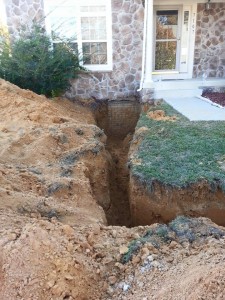 Sewer lines are the system of plumbing pipes in each home. They move waste water from the home to the sewer mains. Each homeowner is responsible for sewer line pipe that connects the pipes in their home to the main sewer line, which is usually in a street. Because the pipes that connect their home are buried and out of sight, homeowners usually don’t have any clue to potential problems until it’s too late. And, when it’s too late it creates a very expensive job.
Sewer lines are the system of plumbing pipes in each home. They move waste water from the home to the sewer mains. Each homeowner is responsible for sewer line pipe that connects the pipes in their home to the main sewer line, which is usually in a street. Because the pipes that connect their home are buried and out of sight, homeowners usually don’t have any clue to potential problems until it’s too late. And, when it’s too late it creates a very expensive job.
When should I clean my sewer line?
Generally, sewer lines should be cleaned as needed. But, it is important to note that neglected sewer lines can lead to a clogged system. A clog will eventually cause a backup of the line and raw sewage to spill into your home. A backup can cause a lot of damage and you will have to repair the sewer line or replace it. To prevent any issues, it’s important to have your sewer lines inspected by a professional about once a year.
When should my sewer line be inspected?
Your sewer line should be inspected if it’s over forty years old. But, this may need to be done sooner if any of the following factors apply to you:
- You suspect tree roots may have penetrated your underground sewer lines
- Your plumbing lines are draining slowly
According to Pain in the Drain:
Mature trees add beauty and shade to landscapes, but their roots can cause extensive damage to sewer pipes. Roots grow into the pipes because they like it there! Sewer pipes contain water, nutrients and oxygen-the essential elements for trees to grow.
How can I tell if my sewer line is clogged?
Before a clogged sewer lines back up, it provides clues that alert the homeowner that something is wrong. In this way, it is possible to get help before disaster occurs. Some of these clues include:
- A raw sewage smell coming from your drains
- Your toilets and drains start to make gurgling/percolating sounds
- Water pooling around or backing out of toilets or drains.
I’ve heard so much about high-pressure cleanings. What is it and how does it work?
One of the best ways to clean your sewer line is with with high-press water jetters. This method is more effective than a drain auger, also known as a snake or cable, because it cleans the lines instead of just removing blockages. In fact, when a high pressure cleaning is performed by an extensively trained plumbing professional, it will remove food, hair, mineral, deposits, grease, and other blockages.
How can I keep my lines clear and avoid plumbing problems?
You can keep your lines clear without using harsh chemical-based drain cleaners. Simply, fill your sinks with water once or twice a month and drain them. The water pressure will remove any waste that’s in the line and will make sure that water can flow through your pipes properly.
Important Considerations
If you decide to get your sewers cleaned professionally, call two companies, at the very least, to help you find the best deal for your needs. Also, do a little bit of research to make sure that the plumber that you hire is insured, has a good reputation, and has the proper license to work in your area. And, if you have any questions, we are here to help. Just give us a call.
Other Sources:
- http://www.angieslist.com/articles/how-often-should-i-clean-my-sewer-drain.htm
- http://www.angieslist.com/articles/warning-signs-main-sewer-line-clog.htm
This is the first of our 3 Part series on Sewer Line Jetting.
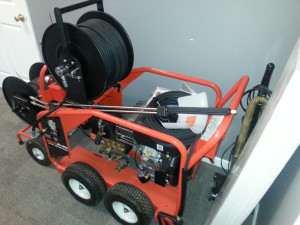 Sewer lines are a vital component of every homeowners property. Yet, most homeowners neglect their sewer lines. That’s understandable. They’re invisible! They’re underground! They have other, more visible, maintenance issues on their property that are higher priorities. But, don’t overlook your sewer lines! All the waste water in your home passes through these valuable lines to get to the sewer system. When there is an obstruction that prevents your sewer lines from working properly, a messy, stinky, damaging and costly backup will occur. But, a regular sewer maintenance program, using a sewer line jetting system, can help prevent backups. The picture on the left is our jetter before we it got dirty.
Sewer lines are a vital component of every homeowners property. Yet, most homeowners neglect their sewer lines. That’s understandable. They’re invisible! They’re underground! They have other, more visible, maintenance issues on their property that are higher priorities. But, don’t overlook your sewer lines! All the waste water in your home passes through these valuable lines to get to the sewer system. When there is an obstruction that prevents your sewer lines from working properly, a messy, stinky, damaging and costly backup will occur. But, a regular sewer maintenance program, using a sewer line jetting system, can help prevent backups. The picture on the left is our jetter before we it got dirty.
About Sewer Line Jetting
The main causes of sewer line drain line blockages are sludge, grease, minerals, and tree roots. For your sewer lines to operate properly, all of these obstructions must be removed. If this issue is neglected, it will cause extensive and expensive damage to your sewer system. For instance, your front yard may have to be excavated to make the necessary repairs (please the picture below).
High pressure sewer line jetting is an economical, efficient, powerful, and eco-friendly way to clean your sewer and drain pipes. These water jets direct powerful and concentrated streams of water to remove blockages by:
- Decimating roots
- Flushing your system
- Removing grease
- Removing hardened scale
- Breaking up debris and sludge
How Sewer Line Jetting Works
Plumbing professionals use a flexible hose and innovative nozzles and attachments to propel water into the sewer line. Using different attachment and nozzles allows these professional to control the cleaning process and direct the powerful streams effectively. When properly used, high jets will have your drain or sewer line looking virtually brand new.
Every pipe requires different levels of water pressure to get a thorough cleaning. For example, the line that’s in the kitchen requires a water pressure of approximately 1,500 PSI to be cleaned effectively. Larger lines, like those used for commercial purposes, might require 3000 PSI or more. Other factors that affect the level of water pressure needed include:
- The material used to make the line: Lines that are made out of strong materials can withstand higher levels of pressure and vice versa.
- The material causing the clog: Tree roots will require higher water pressure than sludge or dirt. Benefits of Sewer Line Jetting
- There are other advantages to using a high power water jetting system. Two of them include:
- Pressurized water is very powerful. In fact, under the right circumstances, water jets can cut through aluminum and steel. This level of water pressure isn’t used when cleaning sewer lines but the principle is the same.
- It unclogs AND cleans your sewer lines: Rotating snakes are a temporary fix when it comes to clearing clogs. They work by making a hole in the clog to get things moving. High powered water jetting systems offer a long lasting solution because they flush your lines out and remove all debris.
- Sewer line jetting is an economical option: A cleaning performed by a sewer line jetting system lasts up to four times longer than one done by a mechanical snake. In other words, just one sewer line jetting will save you money over time.
I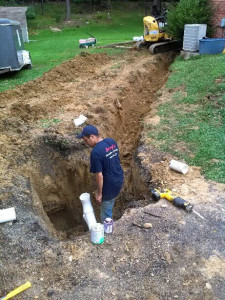 n summary, sewer line jetting can save you money! We would much rather perform this service for our customers to help avoid more costly repairs and maintenance (see picture on the left). We’ve had several jobs where we have had to tear up customers lawns, rent costly backhoes and spend countless hours with a large crew to get the work done right. You can avoid these more costly repairs by having us perform sewer line jetting. That’s a whole lot less expensive than replacing your sewer lines. We are here to help… give us a call!
n summary, sewer line jetting can save you money! We would much rather perform this service for our customers to help avoid more costly repairs and maintenance (see picture on the left). We’ve had several jobs where we have had to tear up customers lawns, rent costly backhoes and spend countless hours with a large crew to get the work done right. You can avoid these more costly repairs by having us perform sewer line jetting. That’s a whole lot less expensive than replacing your sewer lines. We are here to help… give us a call!
You can read more about sewer line jetting by following the links below:
- http://www.rotorooter.com/water-jetting/
- http://www.ultimatewasher.com/sewer-jetting.htm
- http://waynesdrains.com/?services=residential-sewer-cleaning
- http://blackdiamondtoday.com/blog/hydro-jetting-sewer-lines
- http://www.plumbingprofessors.com/sewer-issues/water-jetting/
 A sewer line camera is now a powerful tool in the plumbing industry. We understand the value it offers our customers.
A sewer line camera is now a powerful tool in the plumbing industry. We understand the value it offers our customers. Here’s another major advantage of a sewer line camera inspection. We can often avoid or minimize the “dig.” The dig is an expensive and labor intensive process. Obviously, its much less expensive to the homeowner is we can clean the sewer line with out jetter.
Here’s another major advantage of a sewer line camera inspection. We can often avoid or minimize the “dig.” The dig is an expensive and labor intensive process. Obviously, its much less expensive to the homeowner is we can clean the sewer line with out jetter.






